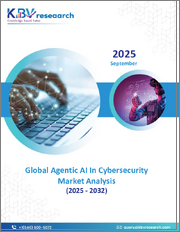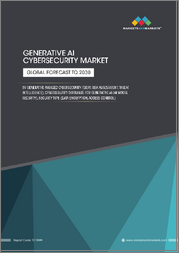
|
시장보고서
상품코드
1529415
세계의 생성형 AI 사이버 보안 시장 규모 조사 : 제공 제품별, 생성형 AI 기반 사이버 보안 솔루션별, 생성형 AI용 사이버 보안 솔루션별, 최종 사용자별, 지역별 예측(2022-2032년)Global Generative AI Cybersecurity Market Size Study by Offering, by Generative AI-based Cybersecurity Solutions, by Cybersecurity Solutions for Generative AI, by End-user and Regional Forecasts 2022-2032 |
||||||
세계 생성형 AI 사이버 보안 시장은 2023년 약 53억 2,000만 달러 규모로 평가되며, 예측 기간인 2024년부터 2032년까지 33.4% 이상의 견조한 성장률을 나타낼 것으로 예상됩니다.
생성형 AI 사이버 보안은 AI 모델을 사용하여 현실적인 위협 시나리오를 생성하고, 공격을 시뮬레이션하고, 취약점을 식별하여 사이버 위협을 예측, 탐지 및 대응하기 위해 AI 모델을 사용합니다. 보안 시스템 학습을 위한 합성 데이터 생성, 위협 탐지 및 대응 자동화, 침입 탐지 시스템 강화, 고도화된 사이버 공격에 대한 강력한 방어 메커니즘 개발 등에 활용됩니다. 이러한 접근 방식은 AI의 예측 및 적응 능력을 활용하여 위협 인텔리전스를 개선하고 오탐을 줄이며 전반적인 사이버 보안 태세를 강화합니다.
사이버 보안 분야에서 고급 생성형 AI 솔루션의 도입은 사이버 방어 환경을 빠르게 변화시키고 있습니다. 생성형 AI 기술, 특히 GAN(Generative Adversarial Networks)은 전례 없는 정확도로 사이버 위협을 예측, 탐지 및 완화함으로써 위협 인텔리전스를 강화하고 대응 프로세스를 자동화하고 있습니다. 이러한 기술은 클라우드 서비스와 온프레미스 인프라의 보안을 보장하고 엔드포인트 보안 및 액세스 관리 제어를 강화하기 위해 점점 더 많이 활용되고 있습니다. 사이버 보안 운영 강화와 데이터 포이즈닝 및 복잡한 악성코드와 같은 위협으로부터 AI 네이티브 워크로드를 보호한다는 두 가지 역할로 인해 생성형 AI 시장 확대가 가속화되고 있습니다.
시장의 견조한 성장은 기존 방법으로는 대응할 수 없는 고도화된 사이버 위협의 확산으로 인해 더욱 가속화되고 있습니다. 현실적인 위협 시나리오를 시뮬레이션하고, 학습용 합성 데이터를 생성하고, 탐지 및 대응 메커니즘을 자동화하는 생성형 AI의 능력은 사이버 보안 대책을 크게 강화할 수 있습니다. 또한, 사이버 보안에 생성형 AI를 통합하면 반복적인 작업을 자동화하고 전문적 훈련이 아닌 일반적 적성을 가진 인재를 고용할 수 있어 업계의 기술 격차를 해소할 수 있습니다. 그러나 AI 거버넌스에 대한 우려와 섀도우 IT와 관련된 위험 등의 문제로 인해, 악용을 방지하고 규정을 준수하기 위해서는 강력한 모니터링과 종합적인 직원 교육이 필요합니다.
지역별로는 북미가 기술 발전, 탄탄한 의료 인프라, 사이버 위협의 높은 확산으로 인해 시장을 주도할 것으로 예상됩니다. 반면, 아시아태평양은 특히 인도, 중국 등의 국가에서 AI 연구개발에 대한 공공 및 민간의 대규모 투자와 사이버 범죄 사건이 크게 증가함에 따라 가장 빠른 성장을 보일 것으로 예상됩니다.
목차
제1장 세계의 생성형 AI 사이버 보안 시장 주요 요약
- 세계의 생성형 AI 사이버 보안 시장 규모와 예측(2022년-2032년)
- 지역별 개요
- 부문별 개요
- 제공 제품별
- 생성형 AI 기반 사이버 보안 솔루션별
- 생성형 AI용 사이버 보안 솔루션별
- 최종사용자별
- 주요 동향
- 경기후퇴의 영향
- 애널리스트의 결론 및 제안
제2장 세계의 생성형 AI 사이버 보안 시장 정의와 조사의 전제조건
- 조사 목적
- 시장 정의
- 조사의 전제조건
- 포함과 제외
- 제한 사항
- 공급측 분석
- 가용성
- 인프라
- 규제 환경
- 시장 경쟁
- 경제성(소비자 시점)
- 수요측 분석
- 규제 프레임워크
- 기술 진보
- 친환경
- 소비자 의식과 수용
- 조사 방법
- 조사 대상년도
- 통화 환산율
제3장 세계의 생성형 AI 사이버 보안 시장 역학
- 시장 성장 촉진요인
- 시장이 해결해야 할 과제
- 시장 기회
제4장 세계의 생성형 AI 사이버 보안 시장 산업 분석
- Porter's Five Forces 모델
- 공급 기업의 교섭력
- 바이어의 교섭력
- 신규 진출업체의 위협
- 대체품의 위협
- 경쟁 기업간 경쟁 관계
- Porter's Five Forces 모델에 대한 미래적 접근
- Porter's Five Forces의 영향 분석
- PESTEL 분석
- 정치
- 경제
- 사회
- 기술
- 환경
- 법률
- 주요 투자 기회
- 주요 성공 전략
- 파괴적 동향
- 업계 전문가의 견해
- 애널리스트의 결론 및 제안
제5장 세계의 생성형 AI 사이버 보안 시장 규모와 예측 : 제공 제품별, 2022-2032년
- 부문 대시보드
- 세계의 생성형 AI 사이버 보안 시장 : 매출 동향 분석, 2022년/2032년
- 소프트웨어
- 서비스
제6장 세계의 생성형 AI 사이버 보안 시장 규모와 예측 : 생성형 AI 기반 사이버 보안 솔루션별, 2022-2032년
- 부문 대시보드
- 세계의 생성형 AI 사이버 보안 시장 : 매출 동향 분석, 2022년/2032년
- 위협 탐지 및 인텔리전스 소프트웨어
- 리스크 평가 소프트웨어
- 노출 관리 소프트웨어
- 피싱 시뮬레이션 및 방지 소프트웨어
- 수복 가이던스·소프트웨어
- 위협 헌팅 및 플랫폼
- 코드 분석 소프트웨어
제7장 세계의 생성형 AI 사이버 보안 시장 규모와 예측 : 생성형 AI 사이버 보안 솔루션별, 2022-2032년
- 부문 대시보드
- 세계의 생성형 AI 사이버 보안 시장 : 매출 동향 분석, 2022년/2032년
- 생성형 AI 트레이닝 데이터 보안 소프트웨어
- 생성형 AI 모델 보안 소프트웨어
- 생성형 AI 인프라 보안 소프트웨어
- 생성형 AI 애플리케이션 보안 소프트웨어
제8장 세계의 생성형 AI 사이버 보안 시장 규모와 예측 : 최종사용자별, 2022-2032년
- 부문 대시보드
- 세계의 생성형 AI 사이버 보안 시장 : 매출 동향 분석, 2022년/2032년
- 은행/금융서비스/보험(BFSI)
- IT &ITeS
- 통신
- 정부 및 방위
- 헬스케어 및 생명과학
- 제조업
- 미디어 및 엔터테인먼트
- 소매 및 E-Commerce
- 에너지 및 유틸리티
- 자동차/운송 및 물류
- 기타 기업
제9장 세계의 생성형 AI 사이버 보안 시장 규모와 예측 : 지역별, 2022-2032년
- 북미
- 미국
- 캐나다
- 유럽
- 영국
- 독일
- 프랑스
- 스페인
- 이탈리아
- 기타 유럽
- 아시아태평양
- 중국
- 인도
- 일본
- 호주
- 한국
- 기타 아시아태평양
- 라틴아메리카
- 브라질
- 멕시코
- 기타 라틴아메리카
- 중동 및 아프리카
- 사우디아라비아
- 남아프리카공화국
- 기타 중동 및 아프리카
제10장 경쟁 정보
- 주요 기업의 SWOT 분석
- 주요 시장 전략
- 기업 개요
- Microsoft(US)
- 주요 정보
- 개요
- 재무(데이터 입수가 가능한 경우)
- 제품 개요
- 시장 전략
- IBM(US)
- Google(US)
- SentinelOne(US)
- AWS(US)
- NVIDIA(US)
- Cisco(US)
- CrowdStrike(US)
- Fortinet(US)
- Zscaler(US)
- Trend Micro(Japan)
- Palo Alto Networks(US)
- BlackBerry(Canada)
- Darktrace(UK)
- F5(US)
- Microsoft(US)
제11장 조사 과정
- 조사 과정
- 데이터 마이닝
- 분석
- 시장 추정
- 검증
- 출판
- 조사 속성
The global Generative AI Cybersecurity Market is valued at approximately USD 5.32 billion in 2023 and is anticipated to grow with a healthy growth rate of more than 33.4% over the forecast period 2024-2032. Generative AI cybersecurity uses AI models to predict, detect, and counteract cyber threats by generating realistic threat scenarios, simulating attacks, and identifying vulnerabilities. Applications include creating synthetic data for training security systems, automating threat detection and response, enhancing intrusion detection systems, and developing robust defense mechanisms against sophisticated cyberattacks. This approach improves threat intelligence, reduces false positives, and strengthens overall cybersecurity posture by leveraging the predictive and adaptive capabilities of AI.
The adoption of advanced generative AI solutions in cybersecurity is rapidly transforming the landscape of cyber defense. By predicting, detecting, and mitigating cyber threats with unprecedented accuracy, generative AI technologies, especially Generative Adversarial Networks (GANs), are augmenting threat intelligence and automating response processes. These technologies are increasingly being leveraged to secure both cloud services and on-premise infrastructures, enhancing endpoint security and access management controls. The dual role of generative AI, in both enhancing cybersecurity operations and safeguarding generative AI-native workloads from threats like data poisoning and complex malware, is driving market expansion.
The market's robust growth is propelled by the rising prevalence of sophisticated cyber threats that traditional methods fail to counteract. Generative AI's ability to simulate realistic threat scenarios, create synthetic data for training, and automate detection and response mechanisms significantly bolsters cybersecurity measures. Furthermore, the integration of generative AI in cybersecurity is addressing the skills gap in the industry by automating repetitive tasks and enabling the employment of personnel with general aptitude rather than specialized training. However, challenges such as concerns over AI governance and the risks associated with shadow IT necessitate robust oversight and comprehensive employee training to prevent misuse and ensure compliance with regulations.
Geographically, North America is expected to dominate the market, driven by technological advancements, a strong healthcare infrastructure, and the high prevalence of cyber threats. The Asia Pacific region, on the other hand, is projected to witness the fastest growth, fueled by extensive public and private investments in AI research and development and a significant rise in cybercrime incidents, particularly in countries like India and China.
Major market players included in this report are:
- Microsoft (US)
- IBM (US)
- Google (US)
- SentinelOne (US)
- AWS (US)
- NVIDIA (US)
- Cisco (US)
- CrowdStrike (US)
- Fortinet (US)
- Zscaler (US)
- Trend Micro (Japan)
- Palo Alto Networks (US)
- BlackBerry (Canada)
- Darktrace (UK)
- F5 (US)
The detailed segments and sub-segment of the market are explained below:
By Offering:
- Software
- Services
By Generative AI-based Cybersecurity Solutions:
- Threat Detection & Intelligence Software
- Risk Assessment Software
- Exposure Management Software
- Phishing Simulation & Prevention Software
- Remediation Guidance Software
- Threat Hunting Platforms
- Code Analysis Software
By Cybersecurity Solutions for Generative AI:
- Generative AI Training Data Security Software
- Generative AI Model Security Software
- Generative AI Infrastructure Security Software
- Generative AI Application Security Software
By End-user:
- BFSI
- IT & ITeS
- Telecommunications
- Government & Defense
- Healthcare & Life Sciences
- Manufacturing
- Media & Entertainment
- Retail & E-Commerce
- Energy & Utilities
- Automotive, Transportation & Logistics
- Other Enterprises
By Region:
- North America
- U.S.
- Canada
- Europe
- UK
- Germany
- France
- Spain
- Italy
- ROE
- Asia Pacific
- China
- India
- Japan
- Australia
- South Korea
- RoAPAC
- Latin America
- Brazil
- Mexico
- RoLA
- Middle East & Africa
- Saudi Arabia
- South Africa
- RoMEA
Years considered for the study are as follows:
- Historical year - 2022
- Base year - 2023
- Forecast period - 2024 to 2032
Key Takeaways:
- Market Estimates & Forecast for 10 years from 2022 to 2032.
- Annualized revenues and regional level analysis for each market segment.
- Detailed analysis of geographical landscape with Country level analysis of major regions.
- Competitive landscape with information on major players in the market.
- Analysis of key business strategies and recommendations on future market approach.
- Analysis of competitive structure of the market.
- Demand side and supply side analysis of the market.
Table of Contents
Chapter 1. Global Generative AI Cybersecurity Market Executive Summary
- 1.1. Global Generative AI Cybersecurity Market Size & Forecast (2022- 2032)
- 1.2. Regional Summary
- 1.3. Segmental Summary
- 1.3.1. By Offering
- 1.3.2. By Generative AI-based Cybersecurity Solutions
- 1.3.3. By Cybersecurity Solutions for Generative AI
- 1.3.4. By End-user
- 1.4. Key Trends
- 1.5. Recession Impact
- 1.6. Analyst Recommendation & Conclusion
Chapter 2. Global Generative AI Cybersecurity Market Definition and Research Assumptions
- 2.1. Research Objective
- 2.2. Market Definition
- 2.3. Research Assumptions
- 2.3.1. Inclusion & Exclusion
- 2.3.2. Limitations
- 2.3.3. Supply Side Analysis
- 2.3.3.1. Availability
- 2.3.3.2. Infrastructure
- 2.3.3.3. Regulatory Environment
- 2.3.3.4. Market Competition
- 2.3.3.5. Economic Viability (Consumer's Perspective)
- 2.3.4. Demand Side Analysis
- 2.3.4.1. Regulatory frameworks
- 2.3.4.2. Technological Advancements
- 2.3.4.3. Environmental Considerations
- 2.3.4.4. Consumer Awareness & Acceptance
- 2.4. Estimation Methodology
- 2.5. Years Considered for the Study
- 2.6. Currency Conversion Rates
Chapter 3. Global Generative AI Cybersecurity Market Dynamics
- 3.1. Market Drivers
- 3.1.1. High efficiency of Generative AI in combating advanced phishing attacks and deepfakes
- 3.1.2. Increasing sophistication of cyber threats
- 3.2. Market Challenges
- 3.2.1. Concerns about AI governance and the risks associated with shadow IT
- 3.2.2. Susceptibility of generative AI models to hijacking and data poisoning
- 3.3. Market Opportunities
- 3.3.1. Generative AI's potential to address the persistent skills gap in the cybersecurity industry
Chapter 4. Global Generative AI Cybersecurity Market Industry Analysis
- 4.1. Porter's 5 Force Model
- 4.1.1. Bargaining Power of Suppliers
- 4.1.2. Bargaining Power of Buyers
- 4.1.3. Threat of New Entrants
- 4.1.4. Threat of Substitutes
- 4.1.5. Competitive Rivalry
- 4.1.6. Futuristic Approach to Porter's 5 Force Model
- 4.1.7. Porter's 5 Force Impact Analysis
- 4.2. PESTEL Analysis
- 4.2.1. Political
- 4.2.2. Economical
- 4.2.3. Social
- 4.2.4. Technological
- 4.2.5. Environmental
- 4.2.6. Legal
- 4.3. Top investment opportunity
- 4.4. Top winning strategies
- 4.5. Disruptive Trends
- 4.6. Industry Expert Perspective
- 4.7. Analyst Recommendation & Conclusion
Chapter 5. Global Generative AI Cybersecurity Market Size & Forecasts by Offering 2022-2032
- 5.1. Segment Dashboard
- 5.2. Global Generative AI Cybersecurity Market: Offering Revenue Trend Analysis, 2022 & 2032 (USD Billion)
- 5.2.1. Software
- 5.2.2. Services
Chapter 6. Global Generative AI Cybersecurity Market Size & Forecasts by Generative AI-based Cybersecurity Solutions 2022-2032
- 6.1. Segment Dashboard
- 6.2. Global Generative AI Cybersecurity Market: Generative AI-based Cybersecurity Solutions Revenue Trend Analysis, 2022 & 2032 (USD Billion)
- 6.2.1. Threat Detection & Intelligence Software
- 6.2.2. Risk Assessment Software
- 6.2.3. Exposure Management Software
- 6.2.4. Phishing Simulation & Prevention Software
- 6.2.5. Remediation Guidance Software
- 6.2.6. Threat Hunting Platforms
- 6.2.7. Code Analysis Software
Chapter 7. Global Generative AI Cybersecurity Market Size & Forecasts by Cybersecurity Solutions for Generative AI 2022-2032
- 7.1. Segment Dashboard
- 7.2. Global Generative AI Cybersecurity Market: Cybersecurity Solutions for Generative AI Revenue Trend Analysis, 2022 & 2032 (USD Billion)
- 7.2.1. Generative AI Training Data Security Software
- 7.2.2. Generative AI Model Security Software
- 7.2.3. Generative AI Infrastructure Security Software
- 7.2.4. Generative AI Application Security Software
Chapter 8. Global Generative AI Cybersecurity Market Size & Forecasts by End-user 2022-2032
- 8.1. Segment Dashboard
- 8.2. Global Generative AI Cybersecurity Market: End-user Revenue Trend Analysis, 2022 & 2032 (USD Billion)
- 8.2.1. BFSI
- 8.2.2. IT & ITeS
- 8.2.3. Telecommunications
- 8.2.4. Government & Defense
- 8.2.5. Healthcare & Life Sciences
- 8.2.6. Manufacturing
- 8.2.7. Media & Entertainment
- 8.2.8. Retail & E-Commerce
- 8.2.9. Energy & Utilities
- 8.2.10. Automotive, Transportation & Logistics
- 8.2.11. Other Enterprises
Chapter 9. Global Generative AI Cybersecurity Market Size & Forecasts by Region 2022-2032
- 9.1. North America Generative AI Cybersecurity Market
- 9.1.1. U.S. Generative AI Cybersecurity Market
- 9.1.1.1. Offering breakdown size & forecasts, 2022-2032
- 9.1.1.2. Generative AI-based Cybersecurity Solutions breakdown size & forecasts, 2022-2032
- 9.1.1.3. Cybersecurity Solutions for Generative AI breakdown size & forecasts, 2022-2032
- 9.1.1.4. End-user breakdown size & forecasts, 2022-2032
- 9.1.2. Canada Generative AI Cybersecurity Market
- 9.1.1. U.S. Generative AI Cybersecurity Market
- 9.2. Europe Generative AI Cybersecurity Market
- 9.2.1. U.K. Generative AI Cybersecurity Market
- 9.2.2. Germany Generative AI Cybersecurity Market
- 9.2.3. France Generative AI Cybersecurity Market
- 9.2.4. Spain Generative AI Cybersecurity Market
- 9.2.5. Italy Generative AI Cybersecurity Market
- 9.2.6. Rest of Europe Generative AI Cybersecurity Market
- 9.3. Asia-Pacific Generative AI Cybersecurity Market
- 9.3.1. China Generative AI Cybersecurity Market
- 9.3.2. India Generative AI Cybersecurity Market
- 9.3.3. Japan Generative AI Cybersecurity Market
- 9.3.4. Australia Generative AI Cybersecurity Market
- 9.3.5. South Korea Generative AI Cybersecurity Market
- 9.3.6. Rest of Asia Pacific Generative AI Cybersecurity Market
- 9.4. Latin America Generative AI Cybersecurity Market
- 9.4.1. Brazil Generative AI Cybersecurity Market
- 9.4.2. Mexico Generative AI Cybersecurity Market
- 9.4.3. Rest of Latin America Generative AI Cybersecurity Market
- 9.5. Middle East & Africa Generative AI Cybersecurity Market
- 9.5.1. Saudi Arabia Generative AI Cybersecurity Market
- 9.5.2. South Africa Generative AI Cybersecurity Market
- 9.5.3. Rest of Middle East & Africa Generative AI Cybersecurity Market
Chapter 10. Competitive Intelligence
- 10.1. Key Company SWOT Analysis
- 10.2. Top Market Strategies
- 10.3. Company Profiles
- 10.3.1. Microsoft (US)
- 10.3.1.1. Key Information
- 10.3.1.2. Overview
- 10.3.1.3. Financial (Subject to Data Availability)
- 10.3.1.4. Product Summary
- 10.3.1.5. Market Strategies
- 10.3.2. IBM (US)
- 10.3.3. Google (US)
- 10.3.4. SentinelOne (US)
- 10.3.5. AWS (US)
- 10.3.6. NVIDIA (US)
- 10.3.7. Cisco (US)
- 10.3.8. CrowdStrike (US)
- 10.3.9. Fortinet (US)
- 10.3.10. Zscaler (US)
- 10.3.11. Trend Micro (Japan)
- 10.3.12. Palo Alto Networks (US)
- 10.3.13. BlackBerry (Canada)
- 10.3.14. Darktrace (UK)
- 10.3.15. F5 (US)
- 10.3.1. Microsoft (US)
Chapter 11. Research Process
- 11.1. Research Process
- 11.1.1. Data Mining
- 11.1.2. Analysis
- 11.1.3. Market Estimation
- 11.1.4. Validation
- 11.1.5. Publishing
- 11.2. Research Attributes



















